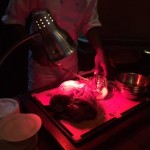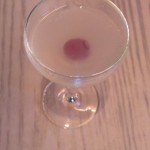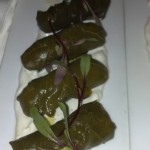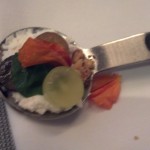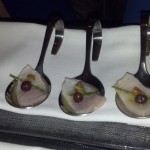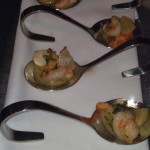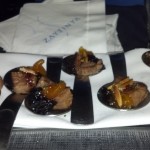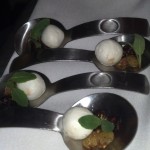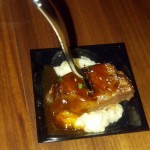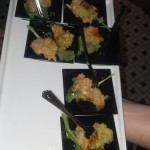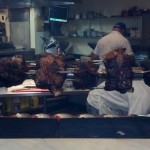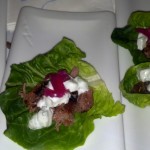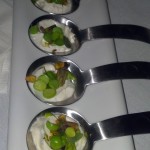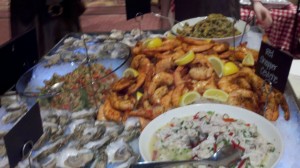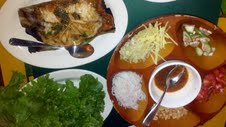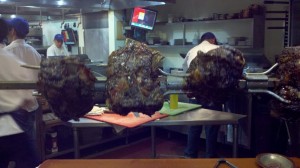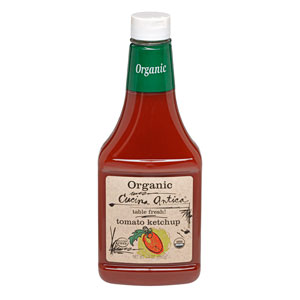
Staflion Granites
On Tuesday evening, it was standing room only at the Grape Festival tasting event at Zaytinya in Northwest DC. The Grape Festival aims to remove the grape from its relegated corner in fruit or chicken salads and the occasional sole Véronique, and thrust it into the entrée spotlight. Personally, I have never done much with grapes beyond eating them straight off the vine in the bag. However, Zaytinya’s Chef José Andrés, Chef Michael Costa, and the rest of the team aspire to turn the grape into an ingredient worthy of the dinner plate. Each of the seven courses served made use of the tiny fruit in exciting and delicious ways.
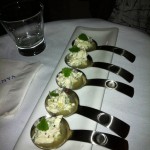
Kavouras Me Agourido
Upon arrival, a host walked me to the Blue Room, which had no tables. A handful of very large glass containers of what appeared to be olive oil provided a balance to the minimalist décor. A waitress proffered a tray holding angular cocktail glasses filled with a bright purple drink. The name of the cocktail was Bacchanalia, and tasted very much like icy, spiked grape juice. I mean that in a good way; it was really rather grape-tasting, not an artificially-flavored concoction. The drink contained Balcones Rumble, lemon juice, house-made grape syrup, and a dash of Peychaud’s bitters. The tart taste complimented the richness in some of the courses being served.
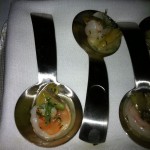
Gariddes Me Ouzo
A couple waiters came through the crowd of about fifty or so, bearing trays with dolmades. They looked traditional on the outside, but a mixture of butternut squash, rice, pine nuts, and tarragon filled the inside. A lemon yogurt sauce had been drizzled over the plate, and the dolmades placed on top, finished with a little fleur de sel. Served warm, the grape-leaf appetizer was delicious. For those of us used to eating our dolmades cold, it’s a pleasant change.
The trays that came around next contained Roka Salata. A small skewer
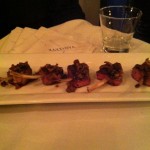
Lamb Chops Agourides
held a couple of baby arugula leaves, a cube of house-made sheep’s-milk myzithra cheese rolled in chopped almonds, a thin slices of radish, and a split grape dusted with sumac. The cheese was very creamy, and the sumac was something new for me. I enjoyed the pungent flavor contrasted with the sweetness of the grape. I would recommend the Roka Salata as a side salad to any entrée at Zaytinya because the flavors are amazing.
Wait staff bearing trays with wide, brushed-finish spoons made their way through the crowd soon after the skewer salads. Mounds of
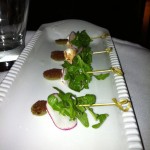
Roka Salata
crab salad filled the spoons; served chilled, the salad mixed crunchy and soft textures with a bit of grape broth in the bottom. I detected crisp apple pieces and chopped fresh grapes, as well as the tang of yogurt in the mixture. The official name of this dish is Kavouras Me Agourido, and I would recommend it as a lunch entrée, perhaps with the Roka Salata.
After the crab salad, a few trays came through with a shrimp dish, but I missed out. Luckily, the wait staff made their way through the crowd again, and I was able to partake in a delicious bite of
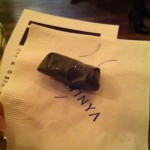
Butternut Squash Dolmades
heaven. A single shrimp nestled with a piece of grape, a piece of green olive, and was sprinkled with dill. It tasted buttery, salty, and a little sweet and was served warm—not to mention, it had been marinated in ouzo. However, the ouzo did not overpower the dish. The proper name for this dish is Garides Me Ouzo, and the Bacchanalia cocktail complimented the rich flavor very well.
Following the shrimp, the wait staff brought around trays of what appeared to be pieces of sushi drizzled with a little olive oil. The
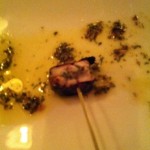
Barbounia Tilihita Se Klimatofila
little rounds were warm though, and turned out to be red mullet, wrapped in grape leaves and stuffed with sultanas and roasted garlic. Quite frankly, the sultanas and garlic were overwhelmed by the fish. I suspect that in entrée-sized portions, the fish would be balanced by the other flavors. The red mullet tasted very fresh, and was grilled perfectly. The official name for this dish is Barbounia Tilihita Se Klimatofila.
Following the red mullet, trays with tiny bone-in lamb chops came through the crowd. The meat was juicy and tender; small mushrooms and chopped grapes rested on top of each tiny chop, and a white wine reduction had been trickled over each. The mushrooms were a variety I had never heard of—honey cap—and truthfully, they tasted similar to a portabello. Of course, it’s possible that the lamb was so delicious that it took center stage in my mouth. The proper name for this dish is Lamb Chops Agourides, and I highly recommend it; the Bacchanalia cocktail seemed just the right drink for the lamb chops.
The last tray to come around contained desserts in a shot glass. Served chilled, the glass held what tasted like a mousse topped by a granita. I was half right. An orange blossom yogurt cream had been piped into the bottom of the glass, and it was topped by a grape granita. Fine diced grapes, candied orange peel, and a tiny mint leaf completed the dessert. I must admit that the orange blossom flavor was overwhelmed by the strong-flavored grape granita. The textures did contrast well with each other, and the creaminess of the yogurt complimented the tart in the granita. The official name for this dessert is Stafylión Granites.
Between the trays of food, I ducked to the back of the room and hit up the wine-tasting table. Zaytinya offered four different varieties consisting of a red, rosé, and two whites. I began with the red, which was made from a Greek variety of grape, the Limnio. The sommelier told me that Aristotle wrote about the Limnio, and the wine itself is still made in Greece. The wine actually smelled a little buttery and had a very smooth, light-bodied taste. It was served at room temperature, looked very clear in the glass, and had strawberry and jammy flavors. The rose was made from Cinsault grapes and Lebanese in origin (described by the sommelier as “a microclimate between two snow-capped mountains”). It looked clear in the glass, served very cold, and was faintly tart. The taste was fruity and silky smooth, with the tartness balancing the sweeter fruit flavors.
The first white I tasted was made from a Greek grape, the Moschofilero, and was served very cold. It was very clear in the glass, and it smelled fruity. The wine tasted tart, light-bodied, and had a faint apricot flavor. The second white I tasted was made from a Greek grape, the Bianco, which now grows in Sicily. This wine smelled yeasty and was clear in the glass. It tasted oaky, full-bodied, and lingered a little in my mouth. I would highly recommend this second white to compliment any of the dishes I tasted at Zaytinya.
-TKW
[ad]









